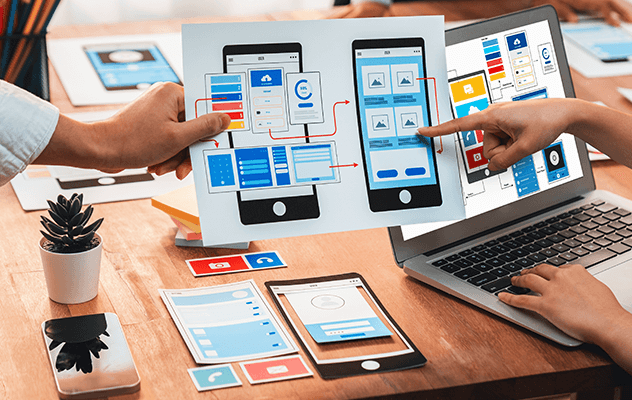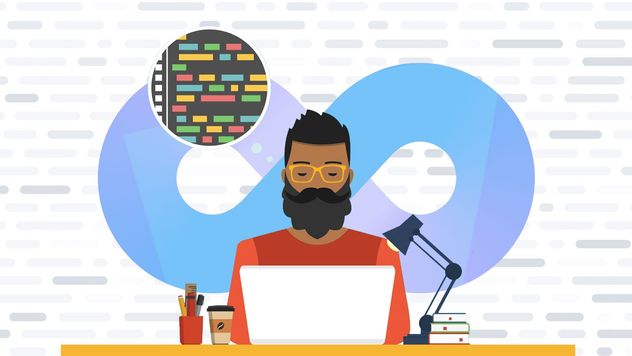
Jump To Section
Take a minute and think about your favourite service that you interact with.
When I say service, I’m referring to the journey or process of getting a task accomplished, not necessarily getting a good as the end product but achieving a desired task. Uber, Amazon Prime, Netflix are all examples of services that people like you and I regularly interact with.
As per this definition, a lot of businesses we see today are at the middle of goods and services.
The end outcome may be a physical product, but the journey of getting that product and all the interactions in between, whether they’re digital or physical, all come under the service.
So, where does Service Design fit into this?
A Background of Service Design
According to the Nielsen Norman Group, “Service design is the activity of planning and organizing a business’s resources (people, props, and processes) in order to directly improve the employee’s experience, and indirectly, the customer’s experience.”
Primarily termed by a marketing executive back in 1982, Service Design initially came about as the idea that every service, every product, or everything that we’re building right now is a service.
However, this interpretation of Service Design got lost in the midst of the Dot Com Bubble — in this era, everybody was all about digital design and product design, and usability became core to it all.
The current world that we live in is an amalgamation of the physical and digital.
And in the realm of the digital world, we often don’t get to see the people and processes that are working behind the scenes.
That’s where Service Design comes in, encapsulating the entire process, end to end.
What is Service Design?
Service design is a relatively new discipline that has gained significant recognition in recent years, especially in the context of technology, user experience (UX), and customer experience (CX) design.
Essentially, service design is the process of creating, optimizing, and innovating services that cater to the needs and expectations of customers and users alike.
The goal of service design is simple, yet complex – to design and deliver services that are effective, efficient, engaging, and enjoyable for everyone involved.
In this blog post, we’ll explore the fundamentals of service design, including its core components, scope, methods, and benefits.
More specifically, we’ll discuss the three key components of service design – people, props, and processes – and how they interact to create a seamless service experience.
We’ll also delve into the scope of service design, including the concept of frontstage and backstage operations.
Service Design: The Fundamental Concept
Service design, as mentioned earlier, is the process of designing or redesigning services to improve the overall user or customer experience.
This process involves a deep understanding of the customers’ needs, preferences, pain points, and motivations.
Service design is also about identifying and mapping the various touchpoints, interactions, and processes involved in delivering a service from start to finish.
Service design is an iterative process that involves researching, ideating, testing, and refining various aspects of a service.
For instance, a service designer may use various design thinking tools and techniques to identify and create personas, customer journey maps, service blueprints, and prototypes.
The goal is to create a cohesive and comprehensive service experience that meets (or exceeds) the expectations of the customers.
The Three Components of Service Design
At a high level, Service Design is composed of three major components:
- People: Any person who creates, uses or interacts with the service or service ecosystem
- Props: Any physical or digital touchpoints, artifacts needed to execute the Service
- Process: Any workflows, procedures, or rituals performed by either the employee or the user throughout a service
These three components interact with each other to create a seamless service experience for the customers.
People
The people component of service design refers to the customers, users, and staff involved in the service delivery. Service designers need to understand the needs and motivations of each stakeholder involved in the service journey to ensure that the overall experience is positive. This could involve interviewing customers, observing staff, or conducting surveys to gather insights.
Props
The props component of service design includes all of the physical and digital elements involved in delivering a service, such as the website, mobile app, signage, furniture, equipment, etc. These elements play a crucial role in shaping the user’s perception of the service and can greatly impact the overall experience. Service designers must ensure that all props are designed to be functional, aesthetically pleasing, and easy to use.
Processes
The processes component of service design includes all of the steps involved in delivering a service, from the customer’s point of view. This could include the ordering process, the payment process, the delivery process, etc. Service designers must ensure that the service processes are easy to understand, efficient, and effective. They should also design processes that are flexible and can adapt to the changing needs of the customers.
The Scope of Service Design
The scope of service design can be divided into two broad categories – frontstage and backstage.
Frontstage refers to all of the activities that the customers can see or experience directly, such as the website, the mobile app, the physical store, or the call center.
Backstage, on the other hand, refers to all of the activities that are not visible to the customers, such as the inventory management, the logistics, or the administrative tasks.
Service designers must take into account both the frontstage and backstage activities to create a cohesive service experience.
They should design processes, systems, and strategies that enable effective coordination between the stakeholders involved in the service delivery. This can involve optimizing workflows, enhancing communication channels, and streamlining operations between different teams or departments.
What is Service Blueprinting and Why You Need It
Service blueprinting is a tool used by service designers to map out the various touchpoints, interactions, and processes involved in delivering a service. A service blueprint is essentially a visual representation of the service journey, from the customer’s perspective. It includes different layers that help service designers identify pain points, opportunities, and areas for improvement.
Service blueprinting typically includes five key layers:
The customer journey: This layer includes the different stages involved in the service journey, from the customer’s point of view.
Frontstage actions: This layer includes all of the activities that the customers can see or experience directly, such as the website, the mobile app, or the physical store.
Backstage actions: This layer includes all of the activities that are not visible to the customers, such as the inventory management, the logistics, or the administrative tasks.
Support processes: This layer includes the supporting processes that enable service delivery, such as internal communication channels, workflows, and standard operating procedures.
Physical evidence: This layer includes all of the physical and digital elements involved in delivering a service, such as signage, furniture, equipment, or branding materials.
Service designers can use service blueprinting to identify areas where the service is falling short or where improvements can be made. This can lead to a better overall customer experience and more efficient service delivery.
UX Vs. CX Vs. SD
UX (user experience) and CX (customer experience) are two terms that are often used interchangeably with service design.
While there are similarities between these disciplines, they are not the same thing.
UX focuses on the user’s interaction with a particular product or service, whereas CX focuses on the customer’s overall perception of a brand or company.
Service design, on the other hand, is focused on the end-to-end service experience, including all of the touchpoints, interactions, and processes involved in delivering a service.
Service design can be seen as an umbrella term that encompasses both UX and CX. This is because service designers need to take into account both the user’s interaction with the service (UX) and the customer’s perception of the service (CX) to create a seamless service experience.
Final Takeaway
Service design is a multidisciplinary and iterative process that involves deep research, ideation, testing, and refinement.
By understanding the three key components of service design (people, props, processes), the scope of service design (from frontstage to backstage), and the basics of service blueprinting, service designers can create a service experience that is effective, efficient, engaging, and enjoyable for everyone involved.
Service design is a highly collaborative and customer-oriented approach that can lead to increased customer satisfaction, retention, and loyalty, as well as reduced costs and improved efficiency for the service provider.
As such, it’s a valuable tool that can benefit a wide range of industries, from healthcare to finance to retail.



